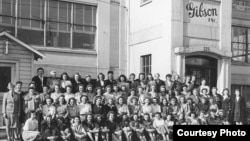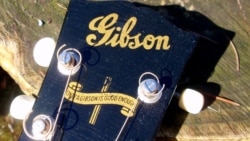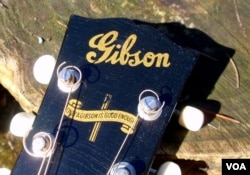PORTLAND, OREGON —
As American men went off to war during World War II, women stepped in to fill the jobs they left behind, keeping the factories and shipyards running, and the economy humming.
While most were praised for their patriotism, one unheralded group of women worked in the shadows building Gibson guitars. The maker of the famous instrument never confirmed that women crafted its guitars during the war, and in an official company history, even reported it stopped producing instruments for those years.
Almost 70 years later, author and guitar aficionado John Thomas is finally telling their story.
He was intrigued by a wartime photo taken at the Gibson guitar factory in Michigan. The 75 people in the black-and-white staff portrait are nearly all women. Irene Stearns, now age 90, spent several of the war years working at the factory.
"I got out of high school and everybody is looking for a job, and there were no jobs," Stearns remembers. "Then one day, they called and I started at Gibson. I suppose it was because of the war."
Stearns is one of a dozen former Gibson factory workers Thomas tracked down in the Kalamazoo, Michigan area. She made guitar strings for some of the thousands of instruments the factory produced in the 1940s.
"All the celebrities and people who were buying the guitars would come," she says. "They would be on the other side of the wall from where I sat making strings. So, it was really nice in that part. I could hear them playing all these beautiful guitars."
Thomas calls Stearns and her former co-workers the "Kalamazoo Gals," which is also the name of his new book about the female guitar makers. In it, he suggests the company kept them a secret because executives believed guitar buyers of the day would not embrace instruments built by women.
It dawned on Thomas that a musical recording would enhance his story. He collected three of the Word War II Gibson guitars and borrowed a dozen more. Then a mutual friend introduced him to professional musician Lauren Sheehan.
"Certainly I'm a champion for a story about women excelling at work that is traditionally a man's domain," Sheehan says. "When he said, 'I'm thinking about making this record and wouldn't it be cool if a woman played the guitar because since it's a women's story,' I thought, this gets better and better; this would be a great project. Then he invited me to do it, completely by surprise. We had known each other for about 20 minutes and he had never heard me play."
Sheehan and Thomas say it's easy to pick out the guitars from the era when women staffed one of the nation's premier instrument factories. The giveaway? A decorative flourish on the headstock.
"Right across the upper third of the guitar, there's a little golden banner that says, 'Only a Gibson is good enough,'" Sheehan says. "That banner is only on these World War II guitars, hence the name 'Banner' guitars. And then the banner disappears."
The banner disappeared after the men came home from war and took up their old jobs making Gibson guitars.
Thomas, who believed the temporary female workforce built more refined guitars, even though they had to deal with raw material shortages, had the vintage guitars x-rayed to support his claim.
He says the state of the art technology measured all of a guitar's components, tops, backs, sides, as well as the internal bracing which reinforces the guitar.
He compared a group of the women-made guitars with groups of guitars made by their male predecessors and successors both before and after the war. The results showed the components of the women-made guitars were all measurable thinner, even for precisely the same models built just after the war by men.
In short, Thomas says, the women's work was more refined which was revealed in the tone of the instruments.
For the new CD that accompanies Thomas’ book, Sheehan played a dozen songs that would've been heard a lot during World War II, each tune on a different vintage Gibson "Banner."
After she finished the recording sessions, Sheehan purchased a restored vintage Gibson 'Banner' for herself, so she too could own a bit of America’s newly-revealed musical heritage.
While most were praised for their patriotism, one unheralded group of women worked in the shadows building Gibson guitars. The maker of the famous instrument never confirmed that women crafted its guitars during the war, and in an official company history, even reported it stopped producing instruments for those years.
Almost 70 years later, author and guitar aficionado John Thomas is finally telling their story.
He was intrigued by a wartime photo taken at the Gibson guitar factory in Michigan. The 75 people in the black-and-white staff portrait are nearly all women. Irene Stearns, now age 90, spent several of the war years working at the factory.
"I got out of high school and everybody is looking for a job, and there were no jobs," Stearns remembers. "Then one day, they called and I started at Gibson. I suppose it was because of the war."
Stearns is one of a dozen former Gibson factory workers Thomas tracked down in the Kalamazoo, Michigan area. She made guitar strings for some of the thousands of instruments the factory produced in the 1940s.
"All the celebrities and people who were buying the guitars would come," she says. "They would be on the other side of the wall from where I sat making strings. So, it was really nice in that part. I could hear them playing all these beautiful guitars."
Thomas calls Stearns and her former co-workers the "Kalamazoo Gals," which is also the name of his new book about the female guitar makers. In it, he suggests the company kept them a secret because executives believed guitar buyers of the day would not embrace instruments built by women.
It dawned on Thomas that a musical recording would enhance his story. He collected three of the Word War II Gibson guitars and borrowed a dozen more. Then a mutual friend introduced him to professional musician Lauren Sheehan.
"Certainly I'm a champion for a story about women excelling at work that is traditionally a man's domain," Sheehan says. "When he said, 'I'm thinking about making this record and wouldn't it be cool if a woman played the guitar because since it's a women's story,' I thought, this gets better and better; this would be a great project. Then he invited me to do it, completely by surprise. We had known each other for about 20 minutes and he had never heard me play."
Sheehan and Thomas say it's easy to pick out the guitars from the era when women staffed one of the nation's premier instrument factories. The giveaway? A decorative flourish on the headstock.
"Right across the upper third of the guitar, there's a little golden banner that says, 'Only a Gibson is good enough,'" Sheehan says. "That banner is only on these World War II guitars, hence the name 'Banner' guitars. And then the banner disappears."
The banner disappeared after the men came home from war and took up their old jobs making Gibson guitars.
Thomas, who believed the temporary female workforce built more refined guitars, even though they had to deal with raw material shortages, had the vintage guitars x-rayed to support his claim.
He says the state of the art technology measured all of a guitar's components, tops, backs, sides, as well as the internal bracing which reinforces the guitar.
He compared a group of the women-made guitars with groups of guitars made by their male predecessors and successors both before and after the war. The results showed the components of the women-made guitars were all measurable thinner, even for precisely the same models built just after the war by men.
In short, Thomas says, the women's work was more refined which was revealed in the tone of the instruments.
For the new CD that accompanies Thomas’ book, Sheehan played a dozen songs that would've been heard a lot during World War II, each tune on a different vintage Gibson "Banner."
After she finished the recording sessions, Sheehan purchased a restored vintage Gibson 'Banner' for herself, so she too could own a bit of America’s newly-revealed musical heritage.











